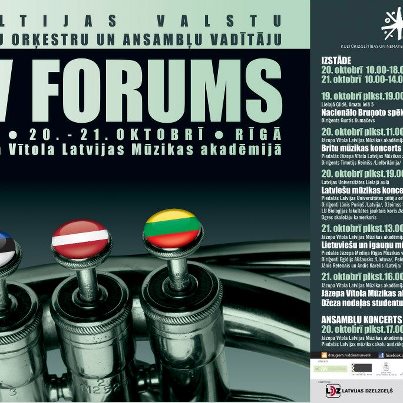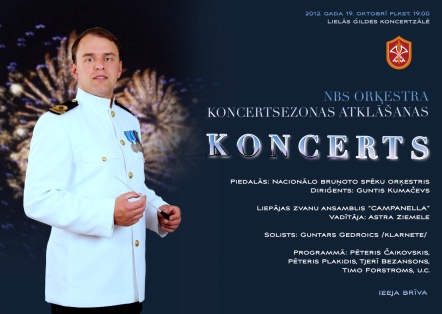WIND MUSIC IN LATVIA
Tim Reynish, November 2012

TWO WORKS OF INTERNATIONAL SIGNIFICANCE
A wonderful week spend in Riga recently for the the Fourth Baltic Forum for Wind Orchestras and Conductors, Latvia, 19 – 21 October 2012, reminded me so much of the old days of BASBWE conferences, with at least four works emerging which are worth exploring to my mind, one perhaps two well worth assimilating into the international wind ensemble repertoire. Peteris Plakidis wrote his clarinet concerto One more Weber Opera in 1993, and it is now available arranged for wind orchestra accompaniment.
The founding of WASBE nearly thirty years ago might by now have given us a good overview of the world of wind music, were our repertoire selections not so dominated by American music, or by the requirements in Europe and Japan of music for contesting. It was therefore fascinating to spend days recently in Riga, capital of Latvia, and to be able to experience a range of music from military and university bands. My host was the indefatigable Janis Purins, and I am indebted to him for information about the history of wind music in Latvia, which I have culled from a comprehensive lecture given in Rider University, Lawrenceville, New Jersey at the 3rd Annual East Coast Band Conference, April 14, 2012.
BRIEF HISTORY OF LATVIA AND ITS MUSICAL TRADITIONS
The history of Latvia and the other Baltic states is of constant change, with periods of Polish-Lithuanian, German (Teutonic Order),Swedish, Russian, Nazi German and Soviet rule. Until middle of 19th. century, music in flourished in churches or in German families, and small groups fulfilled the musical needs of each city, continuing the mediaeval tradition of tower musicians.
Perhaps more than in any other European country, the folk song tradition is especially strong in Latvia; some five hundred years of oral tradition in rural Latvia has been preserved and celebrated, and well over a million folk song texts have been collected by the Archive of Latvian Folklore. This rich folk culture is the main symbol used for the nation’s self identification, the struggle against the Soviet Empire was named the “Revolution of Song” and the 6th President, Vaira Vike-Freiberger, was an eminent folk lore scholar as well as a leader in the politics of the European Union.
THE DEVELOPMENT OF WIND BANDS
The influence of folk traditions on the development wind music repertoire has been of the greatest importance. The middle of 19th saw the abolition of serfdom, and the gradual rise of a professionally educated middle class; Jānis Cimze, educated in Germany, was the first organizer of choirs and instrumental groups. In 1884, the first wind band was formed in Aluksne City by Volunteer Fire Association, and during the the 1890s, the wind band “Hions” (conductor Drekslers) in Riga existed until the First World War. From this period onwards, concerts were regularly given in the Riga city parks by groups such as the Wind Band of Russian army (cond. Buhards) while a band from a rubber factory, 15 musicians, mostly women, also organized regular wind concerts.
In the beginning of the 20th century, the first nationalist repertoire was created for choirs and symphony orchestras by composers such as Jurjānu Andrejs, Emīls Dārziņš, Alfrēds Kalniņš, Emilis Melngailis, the brothers Jāzeps un Jānis Mediņi and Jāzeps Vītols (the first rector of the Latvian Academy of Music, founded in 1919. During the First World War, small bands of 10 – 25 musicians operated almost all major Latvian regions, and Riga had four army bands of 7 musicians, with a repertoire of arrangements of symphonies, marches, overtures, etc. Drama clubs and choruses arose to ensure music for relaxation evenings, and wind bands for dances, In the military, bands became larger and more expert, playing at public events, rallies, meetings, and so at the end of the First World War, well trained musicians of army bands returning to civilian life and became involved in various musical groups – choirs and wind bands.
In 1921 a wind band of the Latvian People University was formed; during the twenties and thirties, bands developed further while in the forties with the political changes under communist soviet regime they played an increasingly important role in the amateur cultural life. Up to this time most of the repertoire represented Western composers’ original compositions and arrangements; however now many professional composers began to write small works for wind orchestras, representing optimism and faith in the future of the Soviet people. One of the first such pieces is Jānis Ivanovs (Ivanov) symphonic poem "Razna". (1940); there are a few works by Ivanovs on CD available from Amazon or Naxos, and of his twenty one symphonies, no. 5 in C Major is almost contemporary with Razna, a free-ranging romantic score, perhaps reminiscent of Shostakovich and Sibelius. It would be fascinating to hear his works for wind orchestra, scores are available in modern editions on line.
After the Second World War, bands developed in various cities of Latvia, alongside song celebrations, various art festivals, music and art Days, and a number of new composers began writing for wind. In 1960, the first Latvian Wind Reunion was held with 20 bands, 542 musicians in one orchestra; these continued every four or five years and featured composers from Lithuania and Estonia. In 1972 the first professional wind band in Riga was founded; its conductor, Gunārs Ordelovskis, was one of the most significant composers in Latvian wind band music, with more than 10 brilliant marches, a variety of dance music (polkas, waltzes), arrangements, arrangements of folk tunes, a number of instrumental concertos (for the horn, for 3 trumpets, the bassoon), a symphony and various suites to his credit.
In recent years, leadership of the bands in Latvia has been largely in the hands of Janis Purins and he has been responsible for the development of courses at the Academy and the structure of the four conferences of Forums, featuring Baltic wind music. Since 1995, the Jazeps Vitols Latvian Academy of Music has provided both bachelor and master
study programs for wind band conducting. EU students’ exchange program through ERASMUS have resulted in a number of guest professors, including Hennie Ramaekers, Fred Dobbelstein , Timo Kotilainen , Lorenzo Della Fonte, Massimo Grespan, Egidijus Ališauskas, Jan van der Roost , Alexander Koops, James Saker, Donald Peteson, Arild Andersen, Peeter Saan and Anatoly Dudin.
Composers at the end of 20th century, beginning of 21th century, active in writing for wind band, include Jānis Ābols, Aivars Krūmiņš, Imants Kalniņš, Juris Karlsons, Aivars Krūmiņš, Andris Vecumnieks, Līga Celma, Pēteris Butāns, Anitra Tumševica, Vilnis Šmīdbergs, Andris Riekstiņš, Rihards Zaļupe and others.
The most active amateur wind bands in Latvia are Riga Technical University Wind Band (conductors: Hermanis Eglītis, Jānis Puriņš, Māris Martinsons) Youth Wind Band Auseklitis (conductor Haralds Bārzdiņš), Wind Band Talsi (conductors: Jānis Smilga, Raitis Rērihs), Wind Band Saldus (conductor Artūrs Maculēvičs), Wind Band Balvi (conductor Egons Salmanis), The University of Latvia Wind Band (conductor Jānis Puriņš), Wind Band of Jazeps Medins Riga Music High School (conductors: Jānis Retenais, Andis Karelis). Since 2009, the annual Forum of the Baltic States Wind Orchestra Conductors and Ensemble Leaders has taken place on the weekend of the 3rd week of October, when during 2 days around 20 activities are held – concerts of wind bands and ensembles, workshops, exhibitions of music instruments and printed music. In March an annual Competition for the Wind Bands of Latvia is held and every second year, an International Competition for Wind Bands - Baltic Open (held simultaneously). Since 1996, an annual summer project has been developed, the Latvia Youth Symphonic Band, when during two weeks of time a wind band of young musicians from all over Latvia is formed. The orchestra plays in a variety of concerts both in Latvia and Europe and participates in international competitions and festivals at the end of each project.
- Janis Purins is the asoc. professor of wind band conducting at Jazeps Vitols Latvian
- Academy of Music in Riga, Latvia.
- Conductor of the University of Latvia Wind Band
- Founder and Conductor of Latvia Youth Symphonic Band
- janis.purins@jvlma.lv
- http://www.facebook.com/purins
CONFERENCE HIGHLIGHTS
- One More Weber Opera - Peteris Plakidis
- Solo clarinet & band
- Big Jig - Thierry Besancon
- Kantate Ziemelblazma - Jaezeps Vitols arr Leons Paegle
- Dzeltens manis kumelinis - Andris Balodis
FRIDAY EVENING CONCERT BY THE NATIONAL ARMED FORCES OF LATVIA WIND ORCHESTRA

The forum began with an excellent concert by the National Armed Forces Wind Orchestra, conducted by Guntis Kumacevs, before an almost capacity audience in the Great Guild Hall which is the major venue for the Latvian Symphony Orchestra. The concert ended with a resounding performances of 1812. And the first half was well constructed with three small works, by composers from Finland, Timo Förstrom, Lithuania, Rimantas Giedraitis, and Estonia, Tonis Korvits, embracing two major works, one by the Swiss composer,Thierry Besanacon which had been commissioned by the Swiss Army Band for their concert for WASBE in Ireland in 2007, and another by the Latvian composer Peteris Plakidis, both hugely enjoyable.

One more Weber Opera Is a most amusing montage, almost Ivesian at times, of excerpts from works by Weber, with a solo clarinet line leading and commenting on the development of thematic material. I was frustrated at not knowing his operas and clarinet music more intimately; despite Stravinsky’s enthusiasm for Weber, whom he called the King of Composers, perhaps ironically, my detailed knowledge is limited to the overtures, but this work, written by Peteris Plakidis in 1993 for clarinet and orchestra and here well arranged by Janis Sandbergs, is well worth exploring in this version for wind. Excellent solo clarinet playing by Guntars Gedroics was well supported by band and conductor, and this is a work which should enter the wind band repertoire.
We do not have enough amusing wind ensemble music, so when two works of that genre turn up, its important to take note. Back in 2007, in my review of the WASBE Conference in Killarney, I wrote…Big Jig, an Irish Radio Fantasy is really good fun, the band fades into three different radio programmes, French, German and Irish, each with their own radio commentator, so that themes appear and collide with other material in an Ivesian way
Coming to the work again, I found it better listening a second time; the programme is important, we need to follow the argument between the radio programmes and the musical content to make sense and get thoroughly involved. Again, I felt that this is a work well worth playing by wind orchestras internationally.
SATURDAY EVENING CONCERT by UNIVERSITY OF LATVIA WIND BAND
The concert was so reminiscent of past Conferences of BASBWE, with a mix of world premieres and more familiar pieces, all splendidly played by the University of Latvia Wind Band, conducted by Janis Purins. The concert began with a march Riga Sveic by Gunārs Ordelovskis, a piece of pomp and circumstance, not especially memorable for except for a most attractive switch of harmony in the trio for one bar.
Was it Malcolm Arnold who said that the trouble with folk songs is that all you can do is to play them again. The second of Three Latvian Folk Songs arranged by Alvils Altmanis, conducted here very sensitively by Janis Purins, is one of the exceptions which proves the rule, a charming song with quite an experimental middle section which I enjoyed. The outside movements were for me not so memorable.
Andris Balodis is a composer better known for his choral music; his Dzeltens manis kumelinis – which translates according to Google as I have a yellow kumelinis – is a charming work in mixed metres, rather in the vein of Derek Bourgeois’ Serenade or Metro Gnome, though with a strangely intrusive foray into jazz right at the end as a coda. Karlis Rerihs’ Suite began with imaginative forest murmurs but then developed into quite a trivial quick march, with a more inventive scherzando second movement, and an attractive Nordic finale. Two other works followed, both influenced by folk traditions, Gamblers Dream by Peteris Butans and Dark Night, a slight but winning work by Bruno Skultes, a strophic song simply scored but effective..
For me the outstanding work of the evening was by the founder of the Conservatoire, Jazeps Vitols, Kantate Ziemelblazma, a Cantata for choir and band with a tenor soloist, cast in a romantic musical language of the early part of the 20th century, reminiscent of the parts songs by Elgar. If you enjoy Elgar and have a good choir, this work would be well worth tackling.
I conducted the Ordelovskis march, and other conductors, also giving fascinating sessions during the weekend, were James Saker and Courtney Snyder from University of Nebraska – Omaha.
BRITISH MUSIC
My own programme with a fine wind ensemble from the Academy, especially put together for the conference, presented a couple of pieces from 1985 in the context of music from 1909 and 1911and a more modern work.
- Suite no 1 in Eb - Holst
- Festivo - Gregson
- Pageant of London - Bridge
- Illyrian Dances - Woolfenden
- Masque - Hesketh
It is most important that Janis and his colleagues continue to commission works annually from the best possible composers; perhaps the Forum could also introduce more foreign music and bring in composers as mentors and leaders of discussion on compositional techniques. James, Courtney and I had the chance to work with conductors studying at the Academy, and again there might be future opportunity to introduce a thread of conducting training alongside composition. All in all, this was a first rate conference, with a great atmosphere; many congratulations are due to Janis Purins and his colleagues